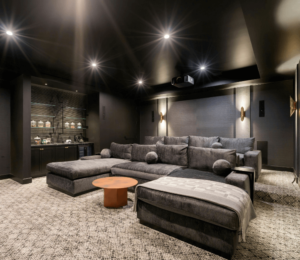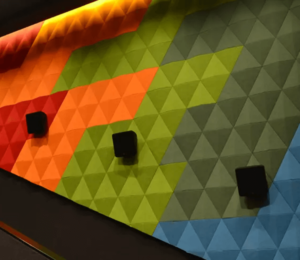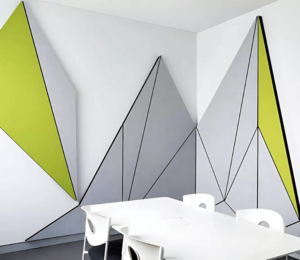In today’s construction and building management, achieving not only energy efficiency but also healthy and comfortable indoor environments is essential. Two prominent sustainability frameworks—the WELL Building Standard and LEED (Leadership in Energy and Environmental Design)—play a vital role in defining acoustic requirements for healthier, greener buildings. Their acoustic criteria focus on reducing noise pollution, improving speech privacy, and enhancing occupant wellbeing.
Understanding what WELL and LEED-compliant acoustic products and solutions entail is crucial for architects, developers, and facility managers aiming to create spaces that meet these rigorous sustainability and health standards.
Table of Contents
What Is the WELL Building Standard and Its Acoustic Criteria?
The WELL Building Standard, developed by the International WELL Building Institute, centers on promoting human health and well-being within built environments. Acoustic comfort is a key pillar of WELL certification because noise is a major factor in stress, distraction, and reduced productivity.
Key Acoustic Requirements Under WELL:
- Sound Level Limits: Maximum allowable background noise levels are specified by space type to prevent noise distractions and support concentration. For example, office areas or conference rooms require lower noise levels than mechanical or service areas.
- Sound Isolation: Walls, doors, and partitions must achieve minimum Sound Transmission Class (STC) ratings (e.g., STC 40-53) to ensure speech privacy and reduce intrusive noise between spaces like offices and conference rooms.
- Reverberation Control: Minimizing echo through acoustic materials enhances speech clarity and overall comfort.
- Sound Masking: Use of sound masking systems to increase privacy and reduce overheard conversations, especially in open-plan spaces.
- Measurement and Verification: Acoustic performance must be quantitatively verified through on-site sound measurements compliant with WELL protocols.
By integrating these acoustic strategies, WELL projects create healthier sound environments that reduce stress, improve cognitive function, and protect hearing health.
What Is LEED and Its Approach to Acoustics?
LEED, developed by the U.S. Green Building Council, primarily focuses on environmental sustainability, including energy, water conservation, and materials. While LEED is less prescriptive than WELL on acoustic comfort, it includes criteria related to noise control and occupant comfort within indoor environmental quality credits.
LEED Acoustic Considerations:
- Encourages use of materials and building assemblies that reduce sound transmission and control noise intrusion (measured by STC and Outdoor-Indoors Transmission Class ratings).
- Promotes design practices that enhance occupant comfort, such as acoustic ceiling tiles, wall insulation, and building layout to reduce noise overlaps.
- Supports the use of low-emission materials that also absorb sound, contributing to healthier indoor air quality and noise reduction.
- Acoustic comfort in LEED mainly contributes to occupant satisfaction and productivity, supporting a holistic, sustainable environment.
LEED-certified projects often overlap with WELL projects in implementing high-performance acoustic solutions for offices, schools, hospitals, and residential buildings.
Examples of WELL and LEED Compliant Acoustic Products and Solutions
To meet WELL and LEED acoustic standards, products must demonstrate performance while aligning with health and sustainability goals:
- High STC-rated Soundproofing Panels & Partitions: Reduce airborne noise between rooms efficiently.
- Recycled PET Acoustic Panels: Environmentally friendly, absorb sound efficiently, and are often low-VOC.
- Wood Wool Acoustic Panels: Natural materials offering sound absorption and sustainable properties.
- Acoustic Ceiling Tiles and Baffles: Designed to control reverberation in open spaces, often certified for low emissions.
- Sound Masking Systems: Implemented as white noise or other sound frequencies to enhance speech privacy.
- Sealing & Air Tightness Products: Acoustic sealants and door/window seals to reduce sound leaks, crucial for meeting STC requirements.
Why Choose WELL and LEED Compliant Acoustic Solutions?
- Support Occupant Health & Productivity: Reduces noise stress and distractions, improving focus and well-being.
- Achieve Required Certifications: Meeting acoustic criteria helps gain and maintain WELL and LEED certification essential for market positioning.
- Enhance Environmental Sustainability: Many compliant products use recycled or renewable materials with low emissions.
- Future-Ready Infrastructure: Quality acoustics aligned with global building standards prepare buildings for evolving sustainability regulations.
GITCO’s Expertise in WELL and LEED Compliant Acoustic Solutions
At GITCO-Saudi Arabia, we provide a full portfolio of WELL and LEED-compliant acoustic products, partnering with leading manufacturers that prioritize health, sustainability, and performance. Serving projects across Saudi Arabia and the Middle East, we deliver acoustic materials and systems tailored to meet certification requirements and support Saudi Vision 2030’s sustainability goals.
Whether you’re designing corporate offices, healthcare centers, schools, or residential complexes, GITCO ensures your acoustic environment promotes health, comfort, and compliance.
Know more about “WELL and LEED Compliant Acoustic Products and Solutions”:
1. Understanding the Certifications
- What is the WELL Building Standard and how does it relate to acoustics? The WELL Building Standard is a performance-based system that measures, certifies, and monitors features of the built environment that impact human health and well-being. Acoustics are a key component, with a dedicated “Sound” concept that aims to create spaces with minimal noise distractions and optimal sound comfort.
- What is LEED certification and what is its focus on acoustics? LEED is a globally recognized green building certification system developed by the U.S. Green Building Council (USGBC). While its primary focus is on environmental sustainability, it addresses acoustics under its Indoor Environmental Quality (EQ) credit category to ensure a healthier and more productive indoor environment for occupants.
- How do WELL and LEED differ in their approach to acoustics? LEED focuses more on the environmental impact of a building, with acoustics being a subset of Indoor Environmental Quality. WELL, on the other hand, puts human health and wellness at the forefront, with a more comprehensive and direct focus on acoustic comfort as a core concept.
- Can a building be both WELL and LEED certified? Yes, they are complementary standards. Many projects pursue both certifications to demonstrate a holistic commitment to both environmental sustainability and occupant health.
2. Acoustic Performance Requirements
- What specific acoustic metrics are addressed by WELL and LEED? Both standards focus on key acoustic performance indicators:
- Sound Transmission/Isolation: Preventing sound from traveling between rooms (measured by STC or Sound Transmission Class).
- Sound Absorption/Reverberation: Reducing echo and reverberation within a space (measured by NRC or Noise Reduction Coefficient).
- Background Noise: Controlling noise from HVAC systems and other sources (measured in dBA).
- What NRC rating do acoustic products need to have to meet these standards? LEED often requires a minimum NRC of 0.70 for ceiling and wall panels in certain areas. WELL has more detailed criteria, but products with high NRC ratings (e.g., 0.85 or higher) are essential to meet their reverberation control requirements.
- How do acoustic products help with sound transmission (STC) for these certifications? Materials like dense foam, mass-loaded vinyl (MLV), or specialized insulated panels are used to increase the STC rating of walls, ceilings, and floors, preventing noise from one room from disturbing occupants in another, which is a key requirement for both WELL and LEED.
- Do these standards apply to mechanical noise (e.g., from HVAC)? Yes, both WELL and LEED have specific prerequisites and credits for controlling mechanical noise. WELL has a “Mechanical Equipment Noise” feature that limits background noise levels, and LEED’s Indoor Environmental Quality credit also addresses HVAC-related noise.
3. Product Features and Compliance
- What materials are used in WELL and LEED compliant acoustic products? Common materials include recycled PET felt (made from plastic bottles), recycled cotton, sustainable wood, and mineral wool. These materials provide high acoustic performance while meeting sustainability criteria.
- Why is being low-VOC (Volatile Organic Compound) important for these products? WELL and LEED place a heavy emphasis on healthy indoor air quality. Low-VOC materials minimize the release of harmful chemicals, which is crucial for achieving credits in the Indoor Environmental Quality category for both standards.
- Do these products need specific certifications to be considered “compliant”? Yes, in addition to product data sheets, a product’s compliance is often verified through third-party certifications like GREENGUARD Gold, a Declare Label, or an Environmental Product Declaration (EPD), which provides transparency about the product’s environmental impact.
- How does an EPD (Environmental Product Declaration) help with LEED/WELL compliance? An EPD provides a full, independently verified lifecycle assessment of a product’s environmental impact. This data is essential for achieving credits in the LEED “Materials and Resources” category and for demonstrating compliance with WELL’s material transparency requirements.
4. Application and Practicality
- Where are these products typically used within a building? They are used in areas where acoustic comfort and performance are critical, such as open-plan offices, conference rooms, classrooms, healthcare facilities, and residential spaces.
- What are some specific types of WELL and LEED compliant acoustic solutions? Products include acoustic ceiling panels, wall panels, suspended baffles, sound insulation for walls and floors, and specialized acoustic foams for HVAC and mechanical systems.
- Are adhesives and sealants also required to be compliant? Yes, to maintain compliance, the entire system must be considered. This includes using low-VOC adhesives and sealants that meet the same environmental and health standards as the acoustic panels themselves.
- Is it more difficult to achieve good acoustics in an open-plan office for these certifications? Yes, open-plan offices present a challenge due to sound reverberation and lack of sound isolation. WELL and LEED address this by requiring a combination of highly absorptive ceiling and wall panels to control reverberation and, in some cases, sound masking systems to ensure speech privacy.
5. Sourcing and Expert Support
- What role does a supplier like Gitco-sa.com play in a WELL/LEED project? A specialized supplier like Gitco-sa.com can provide the specific, certified products required, along with the technical data, submittals, and expert knowledge needed to ensure the materials selected contribute to the project’s WELL and LEED goals.
- How can a project team confirm a product’s compliance? Project teams should request and review the product’s official data sheets, EPDs, and specific certifications from the manufacturer or supplier. The supplier’s technical team can also provide letters of assurance to project auditors.
- What is the difference between a “green” product and a “WELL and LEED compliant” product? A “green” product may simply be made from recycled content. A “WELL and LEED compliant” product goes a step further by meeting specific, documented criteria related to performance, material transparency, and indoor air quality, ensuring it contributes directly to earning points for certification.
- Can a supplier provide a complete WELL/LEED acoustic solution? Yes, a comprehensive supplier like Gitco can offer a full system solution, including the main acoustic insulation materials, compliant accessories (adhesives, tapes), and expert advice on how to integrate them to meet the project’s specific acoustic performance and certification requirements.



